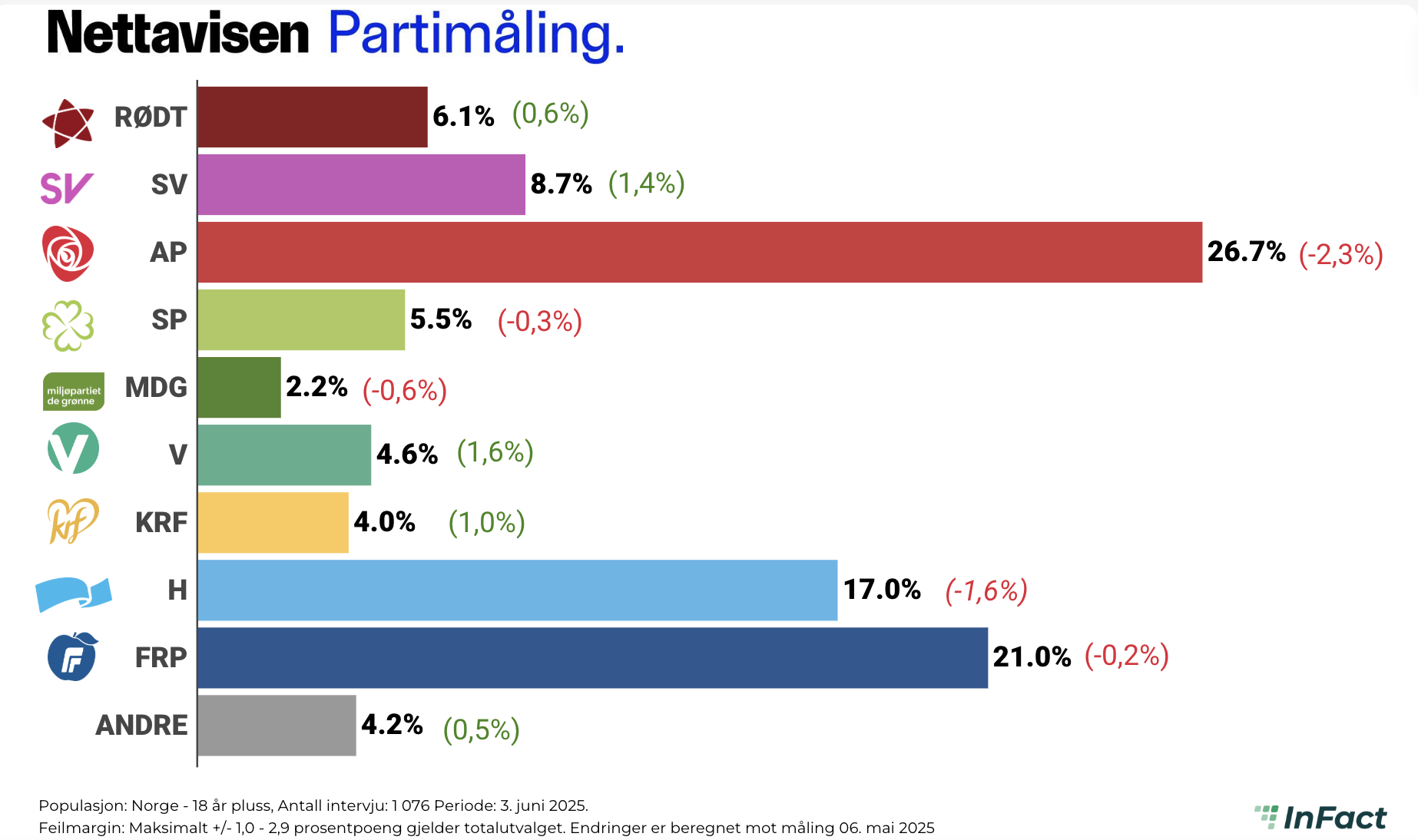The June poll conducted by InFact for Nettavisen shows how small shifts can change the balance of power between the political blocs. When both the Liberal Party and the Christian Democrats manage to cross the electoral threshold, the majority tips to the Right – 85 versus 84 mandates.
The changes in support are mostly within the margin of error, with the exception of the Liberal Party. The largest parties – Labour, Progress Party, and the Conservatives – remain relatively stable. At the same time, the poll highlights how decisive minor voter shifts between the smaller parties can be.

Liberal Party (4.6%) – Above the Threshold and into the Majority Game
The Liberal Party (Venstre) makes a marked jump of 1.6 percentage points and lands well above the electoral threshold. This is the party’s best result in a long time and contributes to securing a majority for the Right.
The party performs especially well in Oslo with 10.7% support – a possible result of extensive campaign activity in the capital.
At the same time, the Liberal Party struggles with low voter loyalty (55.8%) and loses 5.7% of its former voters to the Progress Party. It gains only small shares from other parties.
Christian Democratic Party (4.0%) – Back Above the Threshold
For the first time since July 2024, the Christian Democrats (Krf) climbs back over the threshold and helps tip the balance of power in favour of the Right.
The party is strong on the west coast (9.3%) and among voters over 65 (6.9%). Voter loyalty is solid at 71.4%, but inflow from other parties is weak.
The Labour Party (26.7%) – Still the Largest, but Under Pressure
Labour (Ap) maintains its position as the country’s largest party but falls slightly from the previous poll. However, the decline is within the margin of error.
The party has a clear majority of female supporters (32.8% vs. 21.4% among men) and performs strongest among voters over 65 (40.1%). In Oslo, Labour is significantly weaker (16.5%) than the national average.
Voter loyalty is moderate (67.2%), and the party draws voters mainly from former non-voters (9.9%) and, to a lesser extent, from the Conservatives (3.7%) and the Christian Democrats (2.9%). At the same time, Labour loses significantly to the Conservatives (9%), the Progress Party (4.1%), and undecided voters (12%).
The Progress Party (21.2%) – Strong on the Right
The Progress Party (Frp) holds firm as the largest party on the Right, with support stable since the previous poll.
The Progress Party performs significantly better among men (29.7%) than women (11.2%) and has strong support in the 18–29 age group (31.8%). However, in Oslo, it only gets 11.6%.
The Progress Party has the highest voter loyalty of all parties (80.7%). It wins voters from the Liberal Party (4.7%), Labour (4.1%), and the Red Party (2.3%) but also loses to non-voters (7.3%) and the Conservatives (5.5%).
Conservative Party (17.0%) – Unable to Gain on the Progress Party
The Conservatives (Høyre) gets 17% and continues to lose ground to the Progress Party this month. The decline, however, is within the margin of error.
The party has low voter loyalty (57.6%) but draws a significant share from Labour (9%), the Progress Party (5.5%), and former non-voters (4.3%). Oslo is also a bright spot – the Conservatives gets 30.6% there.
Socialist Left Party (8.7%) – Strong Position Among Young Voters
The Socialist Left Party (SV) performs well, especially among young people (14.1% in the 18–29 age group). It also has strong support in Oslo (15.7%) and Northern Norway (15.6%).
Voter loyalty is 64.3%, and the party gains many former Green Party voters (16.2%). At the same time, it loses some voters to the undecided and non-voters (5.7%).
Centre Party (5.8%) – Voter Exodus After Government Exit
The Centre Party (Sp) continues to struggle. It has low voter loyalty (31.7%) and loses 27% of former voters to the undecided and non-voters. It attracts very few new voters from other parties. The party performs particularly poorly in Oslo, with less than 1%.
The Red Party (6.1%) – Steady Above the Threshold
The Red Party (Rødt) gets 6.1% and remains safely above the threshold. The party’s voter base is demographically broad, and loyalty is moderate (61.4%). There is little voter exchange with other parties.
The Green Party (2.2%) – Far from the Threshold
With just 2.2%, the Green Party (MDG) remains far below the electoral threshold. Voter loyalty is low (51.4%), and the party loses a full 16.2% of former voters to the Socialist Left Party. Currently, the party plays no decisive role in the mandate distribution between the blocs.
Conclusion: Small shifts, Big impact
This poll shows how much of an effect small changes can have on the power balance between the Red-Green and Right side. It only took the Christian Democrats and The Liberal Party crossing the threshold to overturn the solid Red-Green majority from the previous poll. Now, the Right has a razor-thin majority – 85 to 84 mandates.
In other words, the political landscape is highly unstable, and small shifts in voter preferences can tip the majority either way.
Vegard Jarness
PhD and senior consultant
vegard@infact.no
Read the full coverage and party responses in the Nettavisen article.
